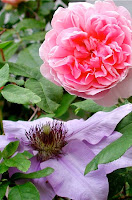 |
I attended the Chelsea Flower
Show in May 1991. That year, a Silver Medal was awarded to a garden called
Gothic Retreat. If I saw it, the plants and design have completely slipped my
mind. You see, I was so gobsmacked by the enormity of the show and the variety
of blooms, I didn’t know which way to turn.
 |
| I trained Cottage Rose as a climber |
That year a hybridizer named
David Austin introduced three roses I later grew in my Maryland Garden. Cottage
Rose, The Dark Lady and Evelyn remain among my favorites.
But Mr. Austin was not new to
Chelsea – in 1983 he unveiled two of his new, old-fashioned “English Roses” to
the world, Graham Thomas and Mary Rose.
The rest, as they say, is
history.
 |
| Chelsea photos courtesy David Austin English Roses |
In 2014, David Austin English
Roses secured an 18th Gold Medal in the Great Pavilion awards. Their
team of eight worked for five days to prepare the display in the main marquee.
Those readers who recall my posting about the 2013 Austin stand may not believe
it, but that year’s presentation was even more stunning.
And in 2014, the show was a also family affair.
David Austin Senior, David
Austin Junior and his son Richard were on hand to celebrate the award. In addition, one of the 2014 Chelsea
introductions was named Olivia Rose Austin after David Junior’s daughter.
 |
| Olivia Rose Austin (courtesy David Austin Roses) |
Because the variety is named
for a family member, it had to be something special. Olivia is the first
offering in their disease-free line and has been in development for almost ten
years. The rose features soft pink
rosette blooms and a fruity fragrance. The
Austin folks believe it might be their best rose to date.
Now, this stunning rose and
two other English beauties will be available to American gardeners in 2016.
The second new introduction,
The Poet’s Wife, has really caught my eye. Technical Manager Michael Marriott
says it is a rare color in the David Austin pastel palette – an unfading rich
yellow. It is a low grower, ideal for the front of the border. The fragrance is
described as lemony, becoming sweeter and stronger with age.
 |
| The Poet's Wife (courtesy David Austin Roses) |
The final new rose to make
its debut next spring is The Lady of the Lake, only the fourth rambler to be
added to the English Rose collection. It promises to grow 10 to 15 feet or more
with long, slender flexible canes.
Unlike many ramblers, it
repeat flowers throughout the summer and boasts a fresh citrus scent. Michael
Marriott reports it may only be hardy to USDA Zone 7, but I intend to give it a
try here in the mountains, even though we are Zone 6b.
So there you have it. The
roses that caused crowds to swoon at Chelsea year before last are headed across
the pond. You can place your orders now at David Austin Roses for spring
delivery.
If you have a rose lover on
your Christmas list, you might want to give a gift certificate. My family gave
me one last Christmas and I used it to get a Darcey Bussell tree rose for my
new garden. What a holiday treat!
Of course the Austin folks
presented three more roses at Chelsea this year: Desdemona, The Ancient Mariner
and Sir Walter Scott.
Since I’m married to a former
officer in the Royal Navy, The Ancient Mariner will be on my must-have list
when it becomes available
Wait a minute – I’m already
getting my heart set on another rose before the 2014 Chelsea winners make their
appearance at my front door?
If you have a bad
case of English rose fever like me, I suspect you can relate.



















-
Follow Us on Twitter!
-
"Join Us on Facebook!
-
RSS
Contact